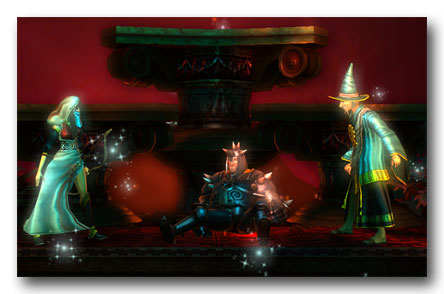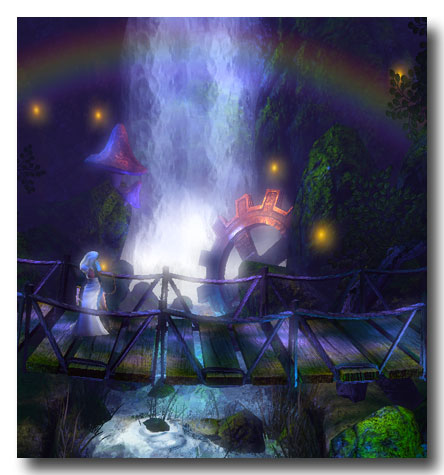“All this jumping around is not for grown men.”

Trine is a platformer for those who ordinarily overlook platformers. Someone who tired of the genre’s limited run, jump, shoot/slash verb set a long time ago might find this 2009 Frozenbyte game a refreshing experience, a platformer which stays faithful to the classic tropes even as it allows the player to easily sidestep them.
The fairy tale look of the game is absolutely gorgeous, the soundtrack is enchanting yet it’s the gameplay which makes this a memorable experience. The game sets up beautiful environments fully realised with a physics engine then lets the player cheekily subvert the science with magic.
Trine’s story tells the tale of three characters magically bound together, forced to rely on each other’s unique abilities to find release. Each of the three provides a markedly dissimilar style of navigating through the game’s 15 levels and the level designs will require the player to regularly switch characters.
The Knight is the most conventional of the three, a portly clod with a play style that will be immediately familiar to platformer veterans. Clad in full plate and packing steel, he is nevertheless capable of hopping around like an overcaffeinated kangaroo. The Knight is ideally suited to deal with foes up close, with a sword to cut down foes and a shield which will keep him safe once adroitly positioned. In time, he will gain a hammer capable of smashing otherwise insurmountable obstacles.
The Thief is the mistress of space. Her bow lets her deal with foes from far and her grappling hook allows her to lower or raise herself and gracefully swing across great distances, neatly bypassing otherwise frustrating jumps. This is a character who rewards skillful play — superior marksmanship lets her arc arrows over obstacles to hit even unseen foes while deft and nimble controlling will let her perform impressive feats of agility.

The Wizard is the most unusual of the three, one whose repertoire of spells would make him a laughingstock in most grand adventures. In this platformer, however, his ability to conjure up boxes and planks (and later on, an unstable floating platform) makes him the most enjoyable character to play. If the situation calls for precision and timing that might be beyond the Knight or the Thief, perhaps two stacked boxes and a cunningly positioned plank might let the Wizard casually saunter across.
Some situations will require the skills of two or more characters. If the Wizard conjured up a floating platform, the Thief could snag her grappling hook onto it to easily swing across a vast chasm. More than a few combat situations might call for the Thief to let loose arrows before quickly switching to the Knight to let his shield deflect answering fire.
The real star of the game is arguably not the three characters but the PhysX physics engine that supports the game mechanics. The delight comes from seeing how the game reacts to your attempts to work with and around the physics. Could you magically levitate that boulder up that high ledge to knock those green bottles down? Yes! What would happen if you jammed a box between those gears? Ha, another annoying jump sequence avoided.
The physics engine can also be a source of frustration since gravity, as pointed out by a wise sage, is a harsh mistress. Those coveted green bottles might drop to the ground, roll and fall into that inconveniently positioned pit of lava; attempts to brace that plank against that high ledge and those two teetering boxes might be repeatedly foiled.

For the most part, though, the frustration level is reasonably low in this modern platformer. Checkpoints, which revive dead characters and heal injured ones, are plenty, and puzzles generally have more than one solution so even with one character dead, it is usually possible to progress to the next checkpoint with the other two.
Trine’s general leniency will leave the player completely unprepared for the final level, Tower of Sarek. It’s entirely understandable the designers would want the ending to be memorable but this is memorable for the wrong reasons. If previous levels allowed and even rewarded a slow deliberate approach, the final level recalls the frantic, frustrating platformer designs of old. Time is of the essence so quick-thinking and precision will be necessary to get through. Dawdling and mistakes are severely punished, and nasty surprises abound. Taken in toto, the player is put under pressure constantly. It’s not that the difficulty is offputting; there’s no natural progression that would lead one to expect the nasty spike in difficulty.
Despite this fairy tale’s grim final chapter, Trine remains an enchanting game and one that’s well worth experiencing. The best fairy tales linger in the memory long after the telling and the player will likely retain fond memories of Trine’s odd blend of physics and magic, classic and modern gameplay long after the frustrations of the Tower of Sarek are forgotten.

Note: In April, Frozenbyte released DLC for the game, a free level which unlocked when the game was completed. If you had trouble with Trine’s last level, the Path to New Dawn DLC will prove frustrating as well. At the very least, however, it’s less of a shock this time around.
